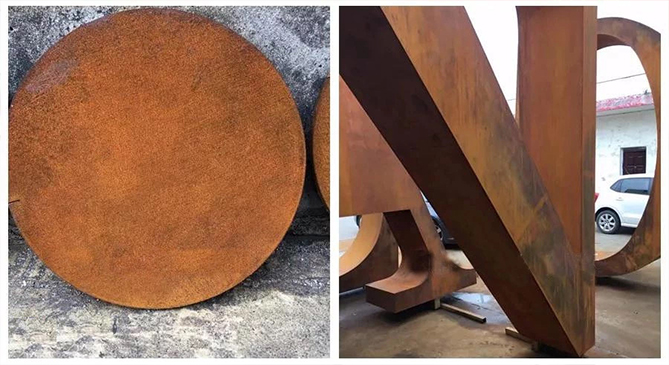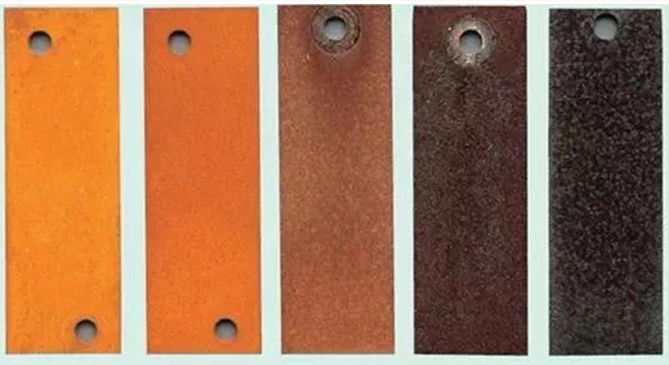

Depending on environmental conditions, it may take years to form a uniform patina. At this point, the metal is protected from severe corrosion in the future by copper rust, so the steel is well suited for bridge structures with a design life of 100 years or more (in the UK, the standard design life for steel and composite Bridges is 100 years).In addition, the color of verdigris changes with age, starting with a reddish brown hue and then gradually darkening. Under normal weather conditions, verdigris takes 18 to 36 months to stabilize its color and eventually turn dark brown, as shown in Figure 2.Therefore, it is important to fully understand the use environment of steel, such as the steel has been placed in a humid environment, will not form a verdigris protective layer. This in itself will create several construction difficulties in terms of design, detail, manufacture and erection. In particular, welds must be designed and welded according to the weather and at the same rate as the filler material. Where there is stagnant water, the corrosion rate will be higher. In the saline air environment, the verdigris protective layer may not stabilize and continue to corrode. There should be no moisture in the steel, and it should be well ventilated to ensure dry and wet circulation, which helps to form a stable verdigris.
From an aesthetic point of view, surface contamination, treatment marks, and welding in the manufacturing process may result in uneven distribution of patina. The absence of these marks on the surface of the original steel is therefore crucial.
Today, most bridge and other structural works using
weathering steel accelerate surface corrosion to form a uniform initial layer of patina. This can be achieved through a pretreatment program, which degreases the surface and then sand blasting to ensure uniform verdigris formation. The plate is then placed in a series of accelerated wet and dry cycles. The water used may contain small amounts of oxidizing agents, such as vinegar or salt water, to increase the rate of verdigris formation. After two months, the above pretreatment will produce red-orange verdigris. However, pretreatment does not stabilize the rust layer. This process reduces color stains on nearby materials, but does not completely remove color stains. The preprocessing is usually done by the steel manufacturer on the final precast section or by a professional contractor. In addition, some steel manufacturers are able to provide such services for intact products.
As with all commodities,
weathering steel can cost more than normal carbon-manganese structural steel of the same strength. However, the cost savings from removing the protective coating system often exceed the additional material costs. The full life cycle cost of
weathering steel Bridges is as much as 30% lower than that of traditional coated steel Bridges. The overall time frame was reduced by the elimination of workshop and field spraying operations, which was beneficial to the contractor and ultimately to the customer. Periodic inspection and cleaning, if properly specified, should be the only maintenance measures required to ensure the continued good operation of the bridge. Because protective coatings are not usually required, the cost of inspection, cleaning, and in some cases, temporary remedial treatment in limited areas is often far less than the cost of regular maintenance and repainting of fully coated structures. This also reduces the overhead costs associated with traffic management required by the site construction access during coating maintenance operations and resulting in traffic delays.
In addition, eliminating steel coating can also avoid problems related to the emission of potentially volatile organic compounds (VOCs) from the coating, which is beneficial to both the environment and workers.

 Depending on environmental conditions, it may take years to form a uniform patina. At this point, the metal is protected from severe corrosion in the future by copper rust, so the steel is well suited for bridge structures with a design life of 100 years or more (in the UK, the standard design life for steel and composite Bridges is 100 years).In addition, the color of verdigris changes with age, starting with a reddish brown hue and then gradually darkening. Under normal weather conditions, verdigris takes 18 to 36 months to stabilize its color and eventually turn dark brown, as shown in Figure 2.Therefore, it is important to fully understand the use environment of steel, such as the steel has been placed in a humid environment, will not form a verdigris protective layer. This in itself will create several construction difficulties in terms of design, detail, manufacture and erection. In particular, welds must be designed and welded according to the weather and at the same rate as the filler material. Where there is stagnant water, the corrosion rate will be higher. In the saline air environment, the verdigris protective layer may not stabilize and continue to corrode. There should be no moisture in the steel, and it should be well ventilated to ensure dry and wet circulation, which helps to form a stable verdigris.
Depending on environmental conditions, it may take years to form a uniform patina. At this point, the metal is protected from severe corrosion in the future by copper rust, so the steel is well suited for bridge structures with a design life of 100 years or more (in the UK, the standard design life for steel and composite Bridges is 100 years).In addition, the color of verdigris changes with age, starting with a reddish brown hue and then gradually darkening. Under normal weather conditions, verdigris takes 18 to 36 months to stabilize its color and eventually turn dark brown, as shown in Figure 2.Therefore, it is important to fully understand the use environment of steel, such as the steel has been placed in a humid environment, will not form a verdigris protective layer. This in itself will create several construction difficulties in terms of design, detail, manufacture and erection. In particular, welds must be designed and welded according to the weather and at the same rate as the filler material. Where there is stagnant water, the corrosion rate will be higher. In the saline air environment, the verdigris protective layer may not stabilize and continue to corrode. There should be no moisture in the steel, and it should be well ventilated to ensure dry and wet circulation, which helps to form a stable verdigris.